Here is my Prague tram no 9 route comprehensive tourist travel guide for 2024. In this guide, I’ll be sharing my favourite quirky and off-the-beaten-track places to visit, along with some great cafes, restaurants, parks and green spaces, and of course, the most popular tourist destinations in the centre of Prague.
While this tram route is not as well known as the no. 22 tram, it’s surprising how many interesting places you can visit on the route.
The middle of the route will take you through the centre of Prague with beautiful views of Prague Castle and Charles Bridge, whilst outside the centre you get to experience the real Prague with no less fabulous places to explore! It’s the perfect tram to take if you want to escape the crowds in Prague for a few hours.

How to use the no. 9 self-guided tram guide
The best way to use this self-guided guide to tram no.9 route is to pick the areas that interest you and start there. You are most likely to board the tram in the centre of Prague at Narodni or Wenceslas Square stop and then travel one way (or the other) depending on what you’d like to see.
You won’t be able to visit absolutely everything in one day. I would say, that each tram stop can easily be seen as half a day trip on its own, but sometimes you can combine attractions from a few stops all together.
If you have a day public transport ticket, you can hop on and hop off whenever you want to and just pick a cafe place, brief visit to the park or walk around the area to get a flavour of what the place is like.
No. 9 tram is one of my favourite routes, not just because it takes me home every day, but because it has such a wide range of places readily accessible from the tram stops.
I’ve visited all the places on my no.9 tram guide, but I’ve done it over a period of several days spread over a couple of years (as you can probably guess from my photos…). There are some places I keep coming back to as there is always something I’ve missed before or because a new cafe, museum or gallery has opened in the meantime.
How to make sure you find the right tram stop
Each heading in my tram guide is the actual name of the tram stop. I’ve listed them in Czech, but included the English translation, where possible. The tram timetables on each tram stop (or on the tram website or on the tram itself) only list the names in the Czech language.
The tram stops are always announced in the tram, so that you know what the next stop is going to be. You also have a digital display of all the tram stops inside each tram carriage, so hopefully, you shouldn’t miss your stop.
If you do miss your stop, you can usually walk back as the tram stops are fairly close to each other or hop on to a tram going back.
My criteria for including sights and places in this guide
To make this self-guided tram guide as easy as possible, I’ve only included places that are visible from each tram stop or very close by (like 3-5 minutes walk).
Since there are literary hundreds of different places I could have included in this guide, I wanted to include the ones I’ve personally visited and keep coming back to.
Of course, I’ll mention the main tourist sites, but I also wanted to share with you my favourite local places, that you might not find in a more traditional tourist guide.
How much does a tram ticket cost?
You can use a single 30 CZK ticket (for 30 minutes only), 40 CZK ticket (for 90 minutes only) or buy a 24 hr ticket for 124 CZK.
The day ticket is best if you want to do shorter visits to places and don’t want to be constrained by time (and constantly remembering to buy tickets or have spare ones).
You can buy tram tickets at larger tram stops (from self-service machines) or inside the tram itself. For more detailed instructions, see my Prague Tram Guide below.
READ MORE
- Guide to Prague tram network – Tickets, Routes & History >>
- How to use public transport in Prague >>
Sidliste Repy
Right at the end of the line of tram no. 9 at Sidliste Repy is the Zlicin train station, the end stop where you can get the Prague Semmering Train.
The Prague Semmering train is a picturesque railway line between Prague’s Smíchov and Řepy. The railway line earned its nickname due to its hilly profile and is named after the Semmering Railway in Austria, which was the first railway without cogwheels that negotiated heights by means of tunnels and viaducts. The Prague Semmering train goes through the beautiful and green Prokopske Valley, negotiates a high railway viaduct and just before Zlicin (Praha – Stodulky stop) goes through another woodland park called Kosire-Motol Natural Park, which is great for walks any time of the year.
The historic train runs during the weekend only, but during the weekday (and weekend too) the train line is used by regular trains from Prague Main Station to Rudna u Prahy or Hostomice. If you have a minimum 40 CZK ticket for public transport for 90 minutes, you can travel on the train without extra charge.
If you want to explore the parks and valleys more (it’s easily a whole day trip with lots of walking in between) I’d recommend to get the day ticket (124 CZK) because you can hop on and off the train without worrying about timings or getting more tickets.
Blatiny
Slanska
Hlusickova

Krematorium Motol
Whilst this stop is for the Motol Cemetary (and Crematorium) it’s also a one of the stops from which you can start exploring the Kosire-Motol Natural Park.
If you walk down the street you will also see the old brewery dating back to 12 century, Motol Pond and on the opposite site (via Za Opravnou Street) Motol Chateau.
The current Motol Chateau look is from 19 century, when it was re-built by the Prague Lesser Town Order of the Knights of Malta. Beforehand, there was an old medieval fort and then in 17 century Krystov Vratislav from Mitrovic built a simple one storey baroque chateau. The Motol Chateau is now owned by the Department of food safety inspection.
The site of the brewery buildings was originally a well know pub going back to the 1607. When the Order of the Knights of Malta took over, they turned the buildings into a brewery. Unfortunately, the brewery was purchased by the Prague town council in 1922 and they closed down the brewery.
When the main road was widened in the middle of the 20th century many of the original buildings were lost. Finally, the area was listed as a historic building in 2001 and in 2006 opened as a hotel and a restaurant. You can still see the Order of the Knights of Malta coat of arms on the main building.
There are more paths leading up to the woodland park by the Motol Pond, where you can also spot an old baroque water mill (now a private residence).
If you are feeling energetic, you can climb up the hill to the cross (Kalvarie Motol) from where you can get a really good view of the Motol area and see the woodland park. The whole area was declared a protected natural monument in 1982 and is about 4 hectares in size.
Motol
If you are in Prague during a summer heat wave you might like to know that just behind the Plzenska Street there is a natural swimming lake open for public swimming from mid May to late September. There is a small entry fee of around 50 CZK, but there are changing facilities, toilets, showers and refreshment stalls. I never found it too busy and the water is much warmer than in Vltava river!
Vozovna Motol
This is a large depo for trams and also transport college. You can see the trams going in and they have a large turning platform for the trams, which you can just about see from the street. Whilst the depo and school are not usually open to public, you can join the locals and the tram drivers at the Kantyna Depak, which serves a simple menu at lunch time. Portions are great and prices are very affordable.

Hotel Golf
Another good stop to get off, if you want to explore natural woodland park Kosire-Motol on the side of the hill.
If you are into cars, you will absolutely love the Trabant museum which you can see from the tram stops right next to the road. Whilst it’s relatively small, it’s packed with all things Trabant. The owners managed to collect an impressive amount of the actual cars, memorabilia, trabant car toys, news cuttings and practically every part of the walls and cabinet displays is covered with something interesting.
Most displays are not in English, but the museum is very interactive and there is plenty to keep the children occupied as you walk around (you can sit in a Trabant or race the toy Trabant cars and a lot more…)
Like many families back in the 80s, we also owned a Trabant. Our was a second-hand blue Trabant combi, which was handy when we had to strap two canoes on the top and all our gear for river rafting and camping trips when we were growing up.
Because of that I absolutely loved seeing all the retro stuff in the museum and it brought a lot of happy memories back.
The entrance fee is 139 CZK for adults and 65 CZK for children or family ticket for 299 CZK. The museum is open all year round from 9 am – 5 pm in winter and 9-6 pm in summer. There is a little shop with Trabant souvenirs and you can also get a basic coffee, tea or soft drink there.
Postovka
In the old days, the hills around the valley where the number 9 tram runs now were mainly wooded areas with individual farmsteads, vineyards and large houses called in Czech ‘usedlost’. There are many of these homesteads surviving in the valley and one perfect example is Cibulka.
You can get to it via street ‘Nad Hlinikem’ and just follow the paths up the hill. As you go up the hill, you might start getting the idea that once this was a well maintained park which belonged to a well-to-do family. You will pass a statue of St John of Nepomuk and on the top of the hill you’ll also see a Chinese pavilion, now beautifully restored. There is also a statue of Zeus, Kronos, Diana and a viewing tower.
The actual Cibulka house is visible, but at the moment closed to general public. It’s been looked after by a charity who is restoring the house and the grounds to make it suitable to be used as a children’s respite centre and hospice for children with cancer from the neighbouring Motol hospital. The charity runs open days several times a year, so you might be able to visit if you are in Prague at the right time.
You can carry on walking in the woodland area and either use the Praha – Stodulky or Praha – Cibulka train stop to get back to Prague’s Main Train Station.
You can also walk down the other side of the hill and you’ll end up in the Prokop Valley, which is another great place to walk. There are bus and underground stops there, so that you can finish your walk any time.
Kotlarka
Kotlarka is a name of another homestead, which you can just about see on the top of the hill as you get off on this tram stop.
It was originally a homestead established in the middle of the 15th century with a large vineyard. One of the more prominent owners was a local builder and architect Josef Becka who lived at the Kotlarka. There used to be also a brick making factory nearby and stone quarry, so it was a perfect location for him and his business.
The Kotlarka homestead is now run as a budget hotel with a restaurant and most of the buildings and outbuildings are visible from the street and from the inner courtyard.
You can take a hike through the Natural reserve called ‘Skalka‘ (the rock). From the top there are some great views of Smichov and the valley below. You can continue through the streets until you reach Ladronka park on the top of another hill or stay on the lower part of the hill and continue to Klamovka Park

Kavalirka
As you get closer to Smichov, the more the modern houses mix with the old houses from the end of 19th century and the beginning of 20th century. At Kavalirka, you can also see the baroque homestead Zamecnice (right on the corner from the main street).
Zamecnice homestead was built on the site of the former Biskupka vineyard, which existed in this area during the 16th century and the building was possibly built in the early 17th century. The first written mention of Zamecnice dates back to 1713. A beautiful baroque garden used to be part of the house and was on the slope above the house. During the first half of the 19th century, the house was updated in a classicist style. The house is now a private residence, but since December 31, 1976, it’s been listed as a protected cultural monument.
You might also notice old-looking and dilapidated houses opposite the Zamecnice house. This is what remains of an old worker’s colony called ‘Budnanka‘. The colony was built between 1820-1840 on the site of a former limestone quarry by mining workers, vineyard labourers from the surrounding area, and workers from the first factories emerging in Smíchov. At the beginning of the 19th century, there were 24 houses in two interconnected alleys with stairs. Almost all residents built their homes from materials found at the abandoned quarry.
The reason why the buildings look like this today is because in the 1980s the houses were bought by the government (mostly against the will of the residents) and the plan was to build a multi-story building for the Ministry of the Interior. The new building was never started as things changed politically during late 1989 because of the Velvet Revolution. Unfortunately, the former owners were not allowed to return, and the houses were left to deteriorate. In 1991, Buďánka was declared a heritage zone, but no one lived in the houses, and no one cared for them, so they began to decay.
Today Budanka is slowly coming back to life and a new café with a community centre has been opened in the former colony, and there is also an information centre for the entire heritage zone.
Klamovka
When you get off from Klamovka tram stop you’ll first see a small white chapel and then a path to a small park. This Klamovka Park – originally a Rococo garden founded by the Clam-Gallas family in the mid-18th century.
Originally, the site of the garden was a vineyard belonging to the Carthusian monastery, which was purchased by the Clam-Gallas family in 1757. The garden was so beautiful and popular that was opened to the public on Sundays and in 1895, it became permanently opened to the public.
At that time, the entire complex was bought by the mayor of Košíře, Matěj Hlaváček, who built a garden restaurant and a ballroom in the Klamovka chateau. In 1904 the first ever cinema in Prague, operated by Dismas Šambor-Ponrepo was also opened in the park complex. Mr. Hlavacek also built an electric railway, which was only the third one in Prague. He built the tram line at his own expense to encourage people to come to his establishment, but sadly not enough people used it. Mr. Hlaváček ended up in debt and sadly hanged himself.
The buildings deteriorated over the years, especially after the First World War. However, in 1915, a Sokol festival was held here and later the buildings were converted into the exercise hall for the Sokol movement, modern tennis courts were built and the garden restaurant was also restored. New family houses were built on part of the Klamovka land in 1924-1926.
U Zvonu
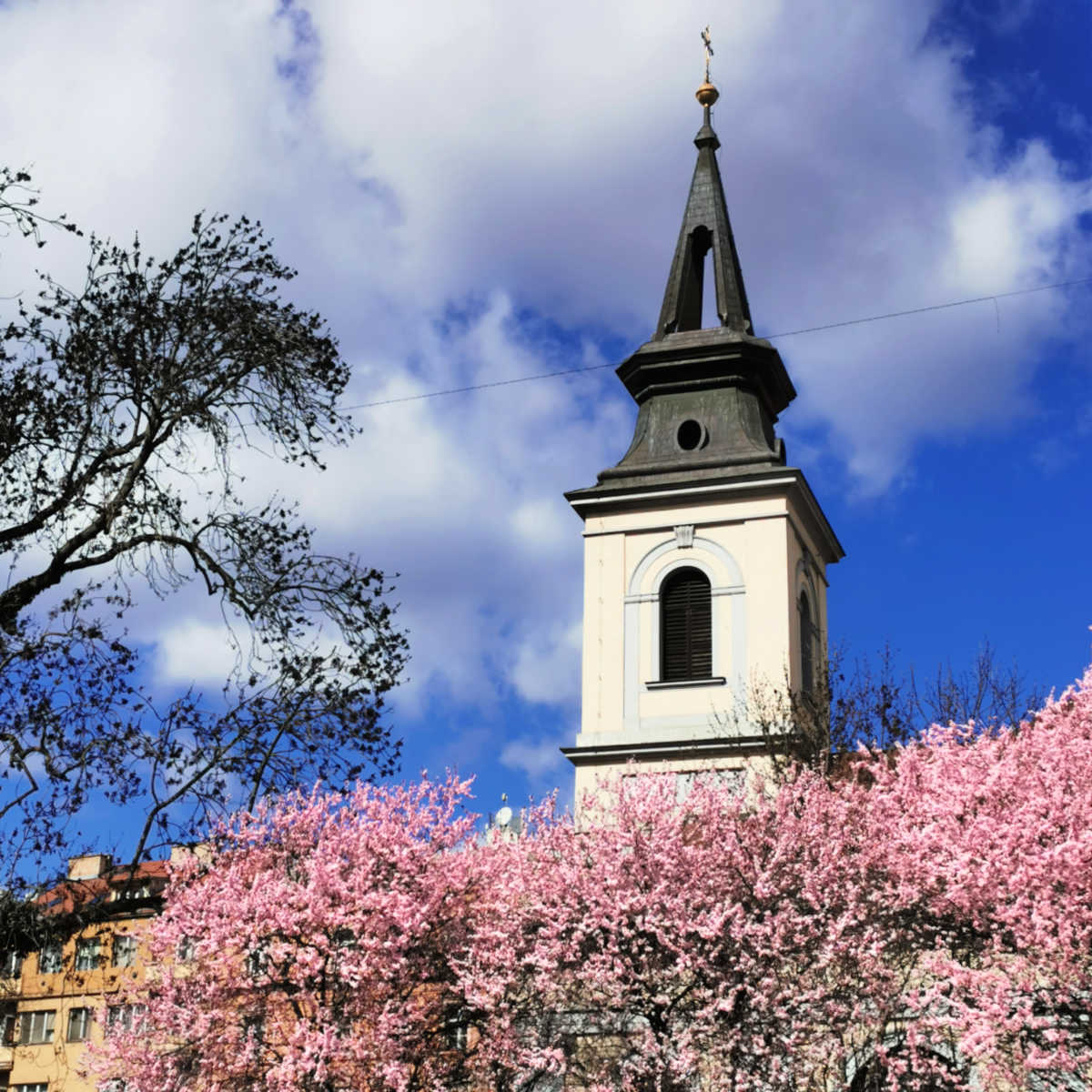
Bertramka
Bertramka Farmstead (closed but an interesting hike), Electrical building now gallery, walk up to st Gabriela Church gallery & side entrance to Kinsky Garden (The museum)
Right on the side of the road, you will see an entrance to the Lesser Town Cemetery.
The name of the cemetery is pretty misleading as it is not located in Lesser Town. The reason for this is that after a change in burial practices during the reign of Joseph II, cemeteries around churches were abolished, and for hygiene reasons, it was permitted to establish cemeteries only outside the city walls.
This is why in 1786, a new cemetery was established on the site of the former plague burial ground, intended for the Lesser Town, Hradčany, Smíchov, and Košíře. At that time, it was surrounded by only a few farm buildings with vineyards. The industrial development of Smíchov, especially the establishment of the Ringhoffer factory in 1852, influenced the growth of residential buildings, which gradually surrounded the cemetery.
In 1884, almost 100 years after its establishment, the last burial took place. Many of the graves were abolished, tombstones and remains of the deceased were relocated to other cemeteries, especially to the Olšany Cemetery and Vyšehrad. This was also done because Plzenska Street was being widened and a part of the cemetery together with the graves and a small part of the church had to go.
It feels very strange to know that when I walk on the pavement next to the cemetery, I’m actually walking over the old graves, including that of Karel Jaromir Erben!
The name ‘Bertramka‘ is taken from another farmstead tucked away behind the busy Duskova Street in a small street heading up to Mrazovka Hill.
Bertramka is a house rebuilt in the classical style surrounded by a beautiful park with a sala terrena, fountain, and bust of W. A. Mozart. The reason why Bertramka is so well known is because the Dusek family lived here and on several occasions, Mozart stayed with them. It was at Bertramka, where he composed his most famous opera Don Giovanni in 1787. The house is currently undergoing re-construction and it’s not open to the public, but you can see the main entry gate and the house and the garden from the street.

Andel
Andel is the centre stop for the Smichov area and it’s great to visit on Friday when one of the Prague’s Farmer’s market is held there. I often buy fresh bread there and also my favourite poppy seeds cake with plum jam and lemon icing.
Tucked away at J.Plachty Street is ‘Ty Kavo!’ coffee place, which not only serves amazing coffee, homemade cakes and open sandwiches but also does regular comedy nights in English!
You can also see a fairly modern Jewish synagogue on the corner opposite the new shopping centre (Novy Smichov). I look across at it when I’m waiting for my tram to go home.
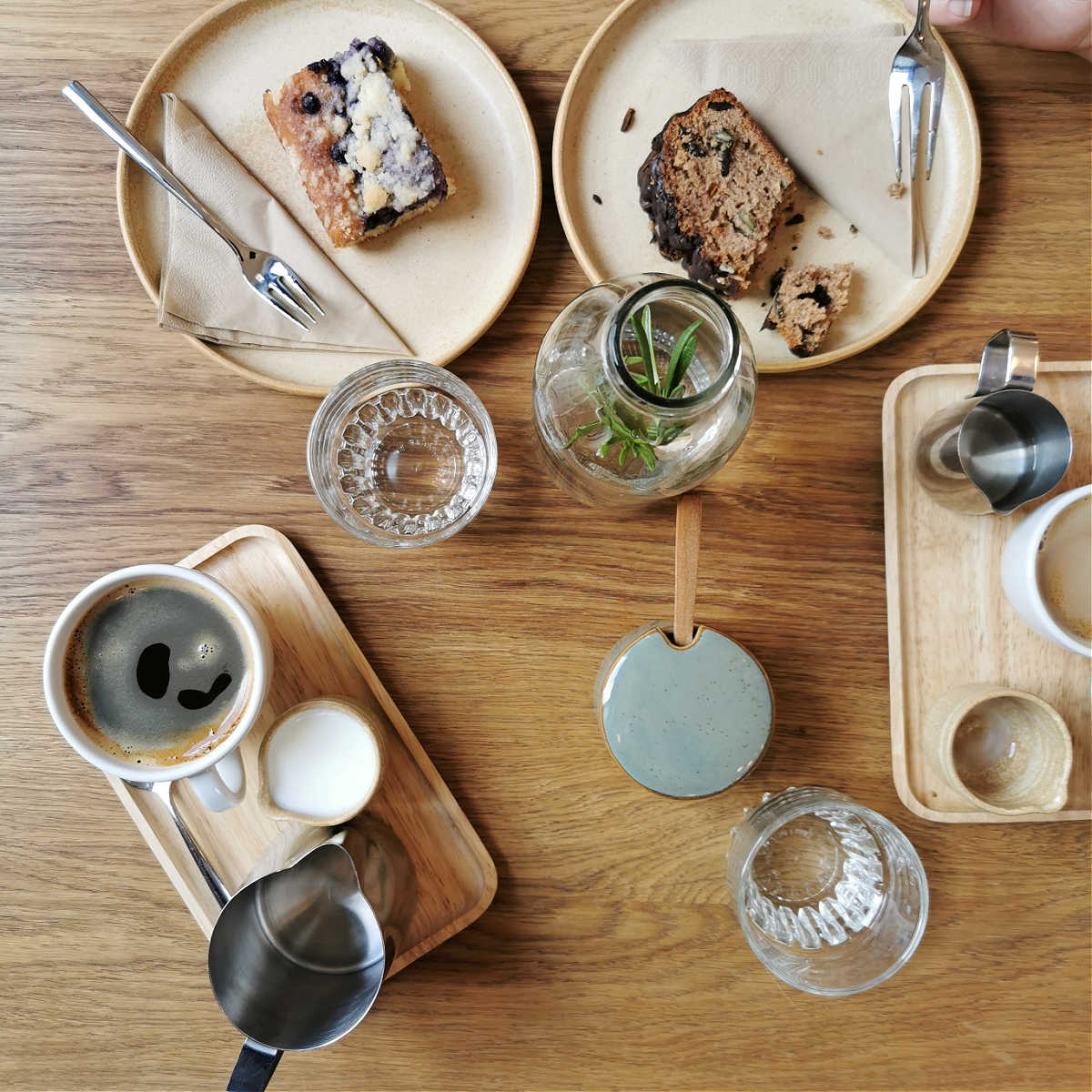
Arbesovo Namesti
There are some amazing examples of late 19th century and early 20th century town houses around the small park on Arbesovo Namesti.
The reason why I normally stop here is to have a bite to eat. For a more traditional, but delicious breakfast head to Kavarna Mezi Radky (Coffee Place in the between the lines), which supports people with learning and physical disabilities by providing employment and fundraising. Your breakfast will taste even better, knowing that you are supporting a good cause.
For lunch I usually pop into Korunka Self Service Restaurant. Korunka restaurant makes traditional Czech food and there are at least 6-10 different types of food to choose from. The restaurant is self-service, which means that it’s like a school canteen – you pick a tray, choose your meal, tell the lady at the counter and she dishes out the hot meal right in front of you. You can also pick any soft drink, salad or dessert as you go around the displays and pay at the end.
The canteen doesn’t have a sit down tables, but there are plenty of standing spaces with tables and people are in and out very quickly. For some reason, most times I go I see chimney sweepers who come here at the end of their shifts. The canteen is open Monday – Friday 7 am – 4 pm and the food prices start from 30-40CZK for soup and 80-120 CZK for main meal.

Svandovo Divadlo
I visit Svandovo Divadlo (Svanda’s Theatre) quite often, because a lot of their plays also have English subtitles.
You can also see the Tank statue by David Cerny at the entrance to Kinsky Garden. The Ethnological Museum has displays about village and country traditional customs and often hosts events such as traditional Czech dancing, cake making or Easter Egg painting.
I often start my Prague Castle hike here and walk through the park and through the historic Hunger Wall to Petrin Hill park and gardens and all the way to the Strahov Monastery and the Prague Castle.
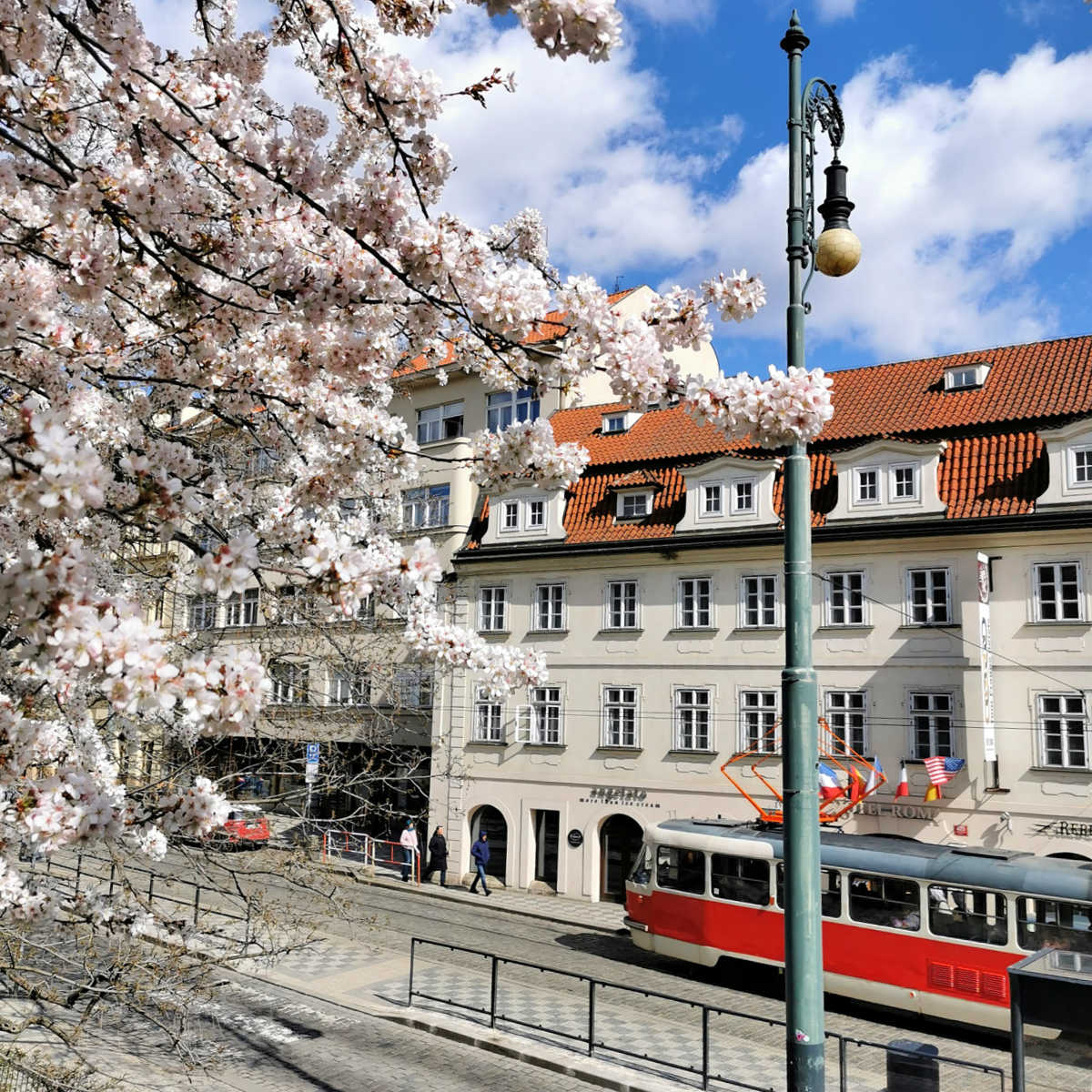
Ujezd
Get off at Ujezd tram stop to take the funicular railway to the top of Petrin Hill, where you can enjoy a panoramic view of Prague, visit the Astronomical Observatory, climb the Petrin Lookout Tower or have a giggle in the Mirror Maze.
If you walk towards the Vltava River on the Vitezna Street you will get to the famous Cafe Savoy, which serves delicious breakfast, lunches and dinners in the very beautiful surroundings of a 1920s style building.
If Cafe Savoy is a little too upmarket for you, then Kofarna Ujezd or Kavarna v Sedmem Nebi just round the corner are relaxed, easy going coffee places with good coffee and homemade cakes and open sandwiches.
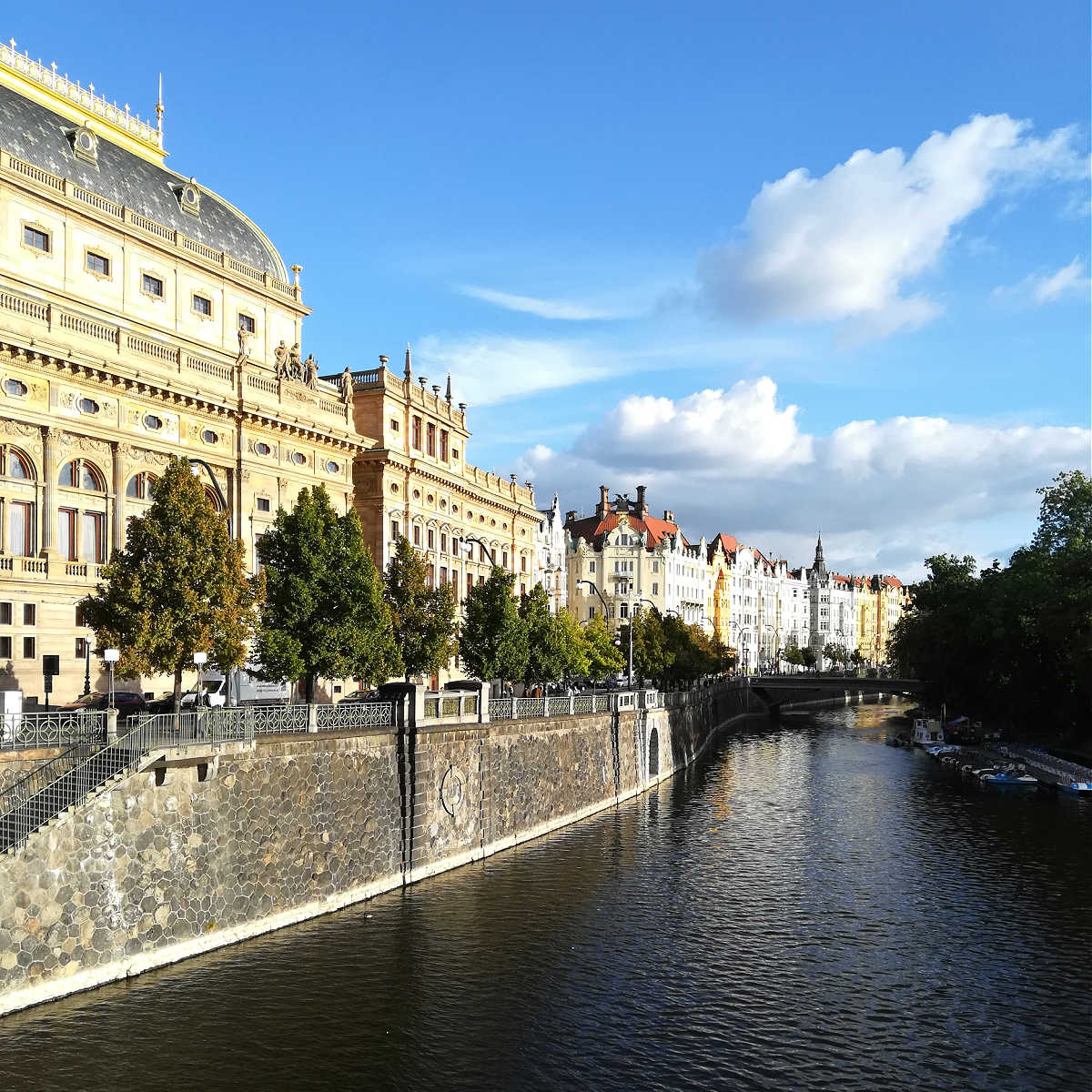
Narodni Divadlo
Narodni Divadlo is the main theatre in Prague and often does guided tours in English (and other languages) and puts on plays, operas and ballets with English subtitles.
You can also have a coffee and cake at the famous Slavia Coffee Place or walk to the Dancing House only a few minutes away following the river bank street.
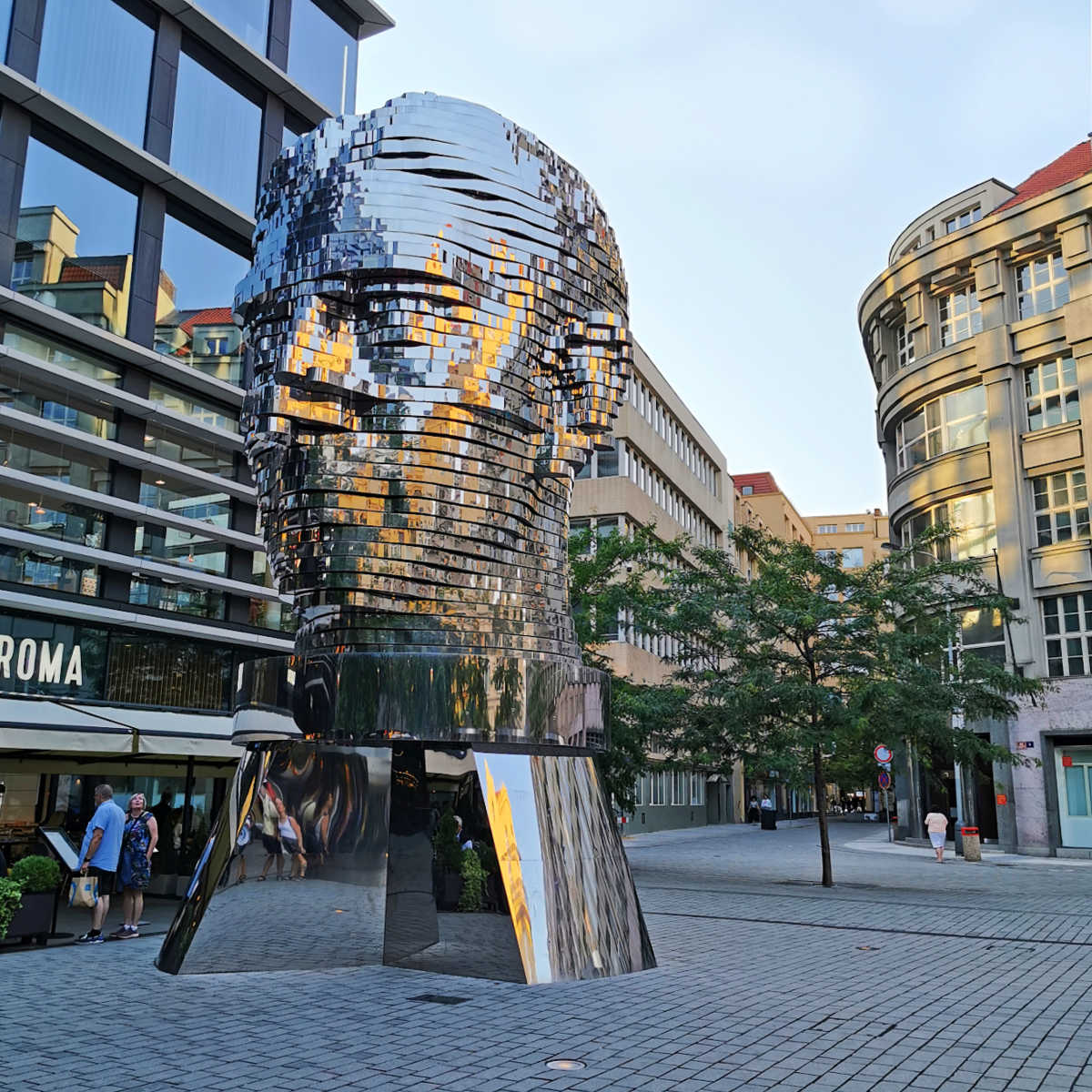
Narodni Trida
Walk through the new shopping centre and you will see the Kafka’s rotating head which layers move randomly every hour for 15 minutes).
Get off here for the closest access to the Old Town Square – walk through the cobbled stones streets (about 7-10 minutes) or once you are close to the Old Town Square turn left for the Kings Route to take you to the Charles Bridge.
Lazarska
Right on the corner as the tram is turning into the Lazarska Street you will see one of the great examples of cubism style in Prague – the Diamond House.
The house was originally built for a local pharmacist František Schnöbling who purchased a piece of land on the corner of Lazarska street at the beginning of the 20th century. The house was built in 1912 by Matěj Blecha’s company with facades in the style of classicizing Art Nouveau based on the plans of F. Ohmann. The facades were pretty much straightaway redone in Cubist style, possibly following Emil Králíček’s design and the house finished the next year (1913).
Interestingly, the house is connected to the Holy Trinity church next door by a Cubist arcade dating back to 1913. This arcade was designed by architect Pfeiffer and features a statue of St. Jan Nepomucký by Jan Brokoff from 1717. The house is still privately owned, but you can walk around and see it from the outside.
The ground floor has a discounted English Book Shop, which is great for holiday novel reading, but they also sell guidebooks, history books and books about Prague in the English language.
Vodickova
Pick up freshly made rolls, traditional Czech cakes, delicious opened sandwiches and other delis from the Liberske Lahudky (open every day until late).
Vodickova tram stop is also the closest stop to walk to Karlovo Namesti Park via Vodickova Street and New Town Hall. The New Town Hall is open to public and you can climb the stairs to view the New Town and Charles Square from the top of the tower.
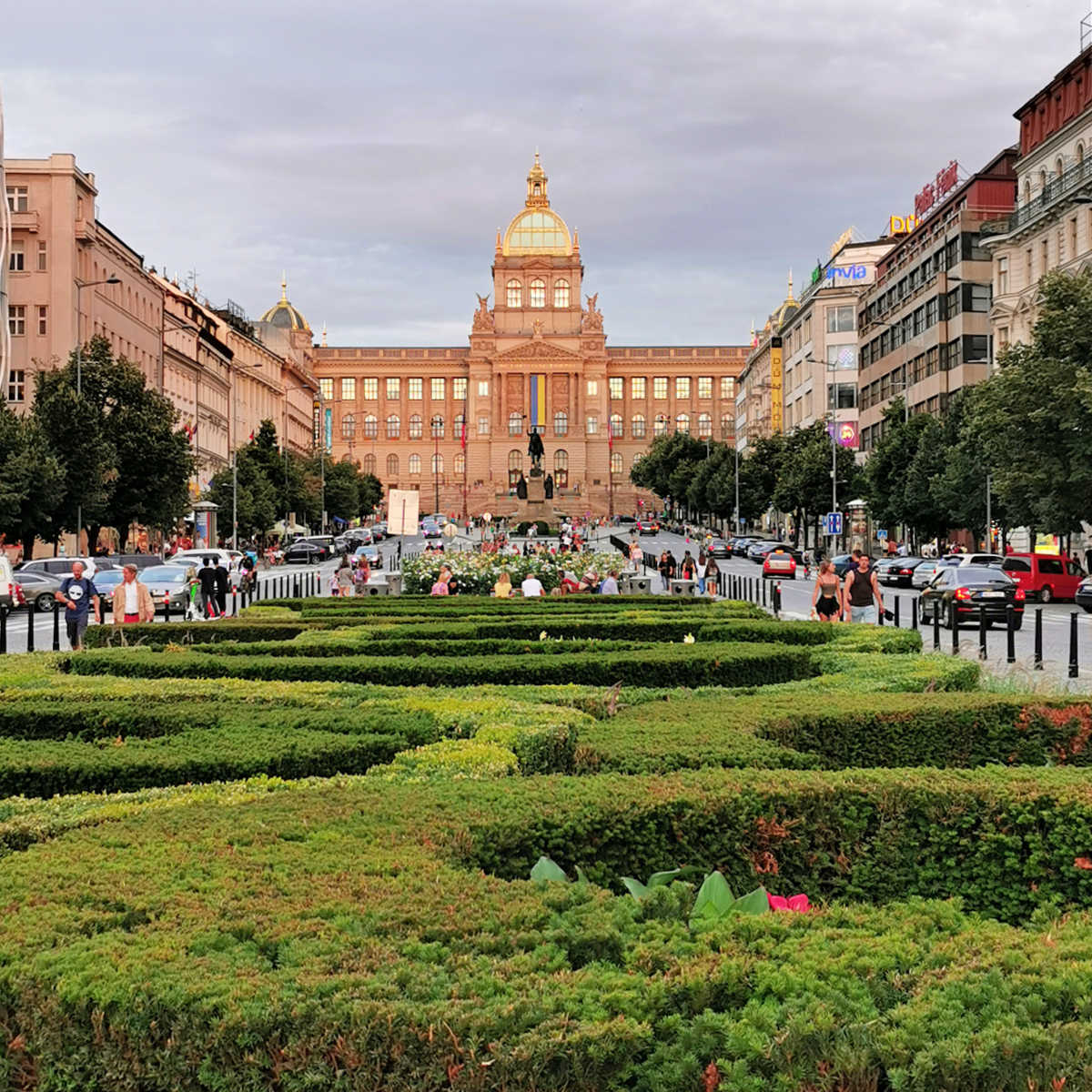
Vaclavske Namesti
Walk down through Wenceslas Square to the Old Town Square or walk up to the National Museum.
Enjoy one of the best ice-creams in Prague at Svetozor. You will also find here Svetozor Cinema and Svetozor self-serving restaurant 7 am – 3 pm – Monday – Friday).
If you walk across Vodickova Street you get to the Lucerna Passage, where you’ll find another art cinema, the famous upside down horse by David Cerny, access to the Lucerna roofs and the Lucerna coffee bar (traditional retro coffee place linked to the Lucerna cinema where everyone has a drink before they go to see the film.
One side passage will also take you to the Novak House Shopping Passage, which was originally built in 1902 in Art Nouveau style. There are many separate shops, art galleries and theatres inside the complex. It’s definitely less busy than the Lucerna passage and a good place just to stroll and enjoy the architecture.

Jindrisska
If you fancy climbing yet another tower, then Jindrisska Tower has a good view from the top and there are also history exhibitions on each level as you are walking up. It’s a little bit difficult to imagine now, but the Jindrisska Tower belonged to the Church that you see on the other side of the tram line – the Roman Catholic Church of St. Henry and St. Kunhuta.
The church wasn’t probably best pleased when towards the end of the 19 century a new tram line was designed to go right in the middle of the church cemetery and in between the church bell tower and the church itself. The small cemetery was turned into a park and the tombstones are now decorating the sides of the church.
If you follow Jerusalemska Street you will see the colourful Jubilee Synagogue.
Jubilee Synagogue was originally called the Synagogue of Emperor Franz Joseph. It was built in 1905-1906 as a replacement for the destroyed synagogues after the clearance of the Prague ghetto. It is the youngest and largest synagogue of the Prague Jewish community. The building is built in an interesting mixture of Art Nouveau and Moorish style and it’s definitely worth visiting.

Hlavni Nadrazi
This is the closest tram stop to the Hlavni Nadrazi – Main Train Station if you need to catch a train for a day trip from Prague. Just walk through the park and the entrance to the station is there.
The Main Train Station is worth a diversion even if you are not going anywhere. I like to have a coffee at the historic Fantova Kavarna (Fanta’s Coffee Place) which is at the top of the old building, set in the old ticket hall. The ceiling is beautifully decorated and you can explore how the train station would have looked like at the beginning of the 20th century.
My other favourite thing to do in Hlavni Nadrazi is to walk through the new underpass to Zizkov and walk to the newly created Churchill’s Square and from there carry on exploring Zizkov district. There are some good views of Prague from there (especially at sunset) and you can stop to have a coffee at the Miners Coffee (which is small chain of locally owned coffee places with a very relaxed atmosphere, great coffee and homebaked cakes.
One of my absolute favourite finds is the entrance to a little path that takes you onto the old railway track just outside the Main Station. The best access is through the new underpass from the station and then heading towards Seifertova Street and crossing it towards Pribenicka Street. You can also get off at Victoria Zizkov and walk down to get to this point.
Once you are on the path, you can’t get lost as the path has been recently opened for pedestrian use. The path is also busy with people on bikes or inline skates, mum’s with children buggies and runners.
The path will take you under the Vitkov Hill and you can climb the stairs to the top. Alternatively, just carry on until you get into the old train tunnel and after that you can get a local Prague bus back to the centre or walk back the same way.

Victoria Zizkov
If you fancy watching a local football match played by one of the top Prague football teams, then get off this stop to walk across the little park to get to Victoria Zizkov Football Stadium. You can also watch the local team practise if you walk to the top of Vitkov Hill on the opposite side.
If you fancy a longer walk, take the Siwiecova Street which will take you via Paradise Garden into Riegrovy Sady (Park) on the top of the hill.
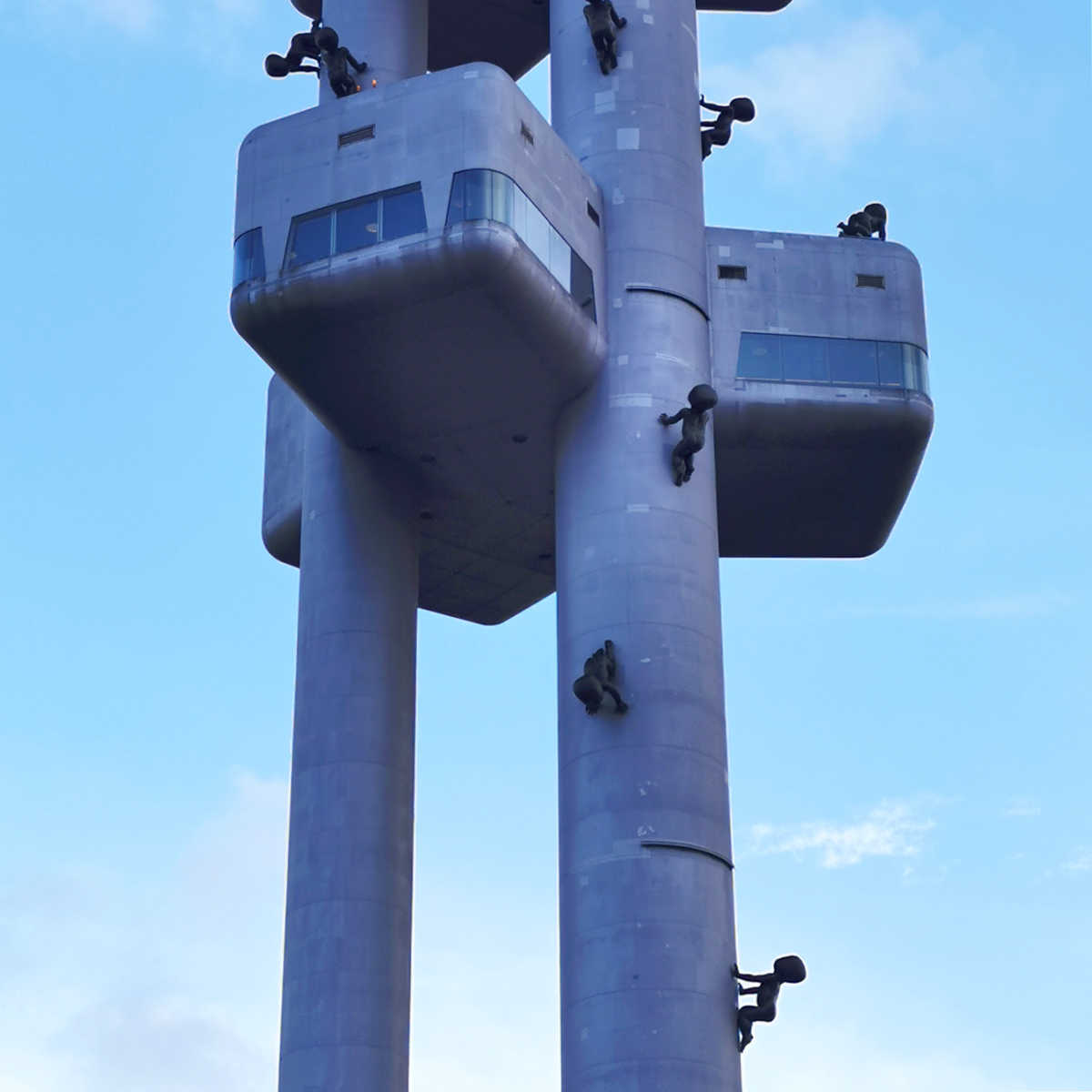
Lipanska
Take Lipanska Street to walk up to the famous Zizkov Television Tower. The tower is open every day and there are great views of Prague from there. There is also a restaurant and a coffee bar, where you can enjoy a drink and watch the clouds.
If you’ve seen the Giant Crawling Babies by David Cerny at Kampa Island, you’ll recognise the rest of them crawling up the tower. They were recently cleaned and it was quite funny seeing them lined up down at the bottom of the tower park before they were put back up.

Olsanske Namesti
Between this and the next stop at Olsanska you will see a round Church of Saint Roch. Behind it you can walk into the largest cemetery in Prague – Olsany Cemetery. It’s very peaceful there and the old part of the cemetery has some amazing headstones set amongst tall trees, woodland shrubs and grassy paths.
I’ve spent a good couple of hours walking around all the different parts of the cemetery and I’ve still not seen everything. One other thing you might see there and very much alive are red squirrels as they hop between the graves.
The Olsany cemetery is the largest burial ground in Prague, covering fifty hectares. The oldest part, Cemetery No. 1, was founded after 1679 on the site of a large garden that its owner, Jakub Štika from the Olšany village, sold to the Old Town community so that they could bury victims of the plague there.
Along with the plague cemetery, a chapel was also built and dedicated to the saint patrons St. Roch, St. Sebastian, and St. Rosalia to protect people against the plague.
In addition to ordinary citizens, many important figures of social and cultural life are buried at the Olsany cemetery. There is an educational trail and display boards that take you through the most important parts of the cemetery.
You can visit the graves of Josef Jungmann (writer), František Čelakovský (writer), playwright Ladislav Stroupežnický, mathematician Bernard Bolzano, Josef Lada (illustrator), Jaroslav Ježek (musician), or Voskovec and Werich (comedy partners, actors & playwright).
Olsanska
Nakladove Nadrazi Zizkov
There are two smaller parks accessible from this station – on one side you have ‘Zidovske Pece’ – Jewish Ovens hill and on the other side ‘Parukarska’. Both have children playgrounds, some refreshments facilities and great views of Prague – especially the Vitkov Hill, The Zizkov Tower and you can also see the Prague Castle and the Petrin Tower in the distance.
Biskupcova
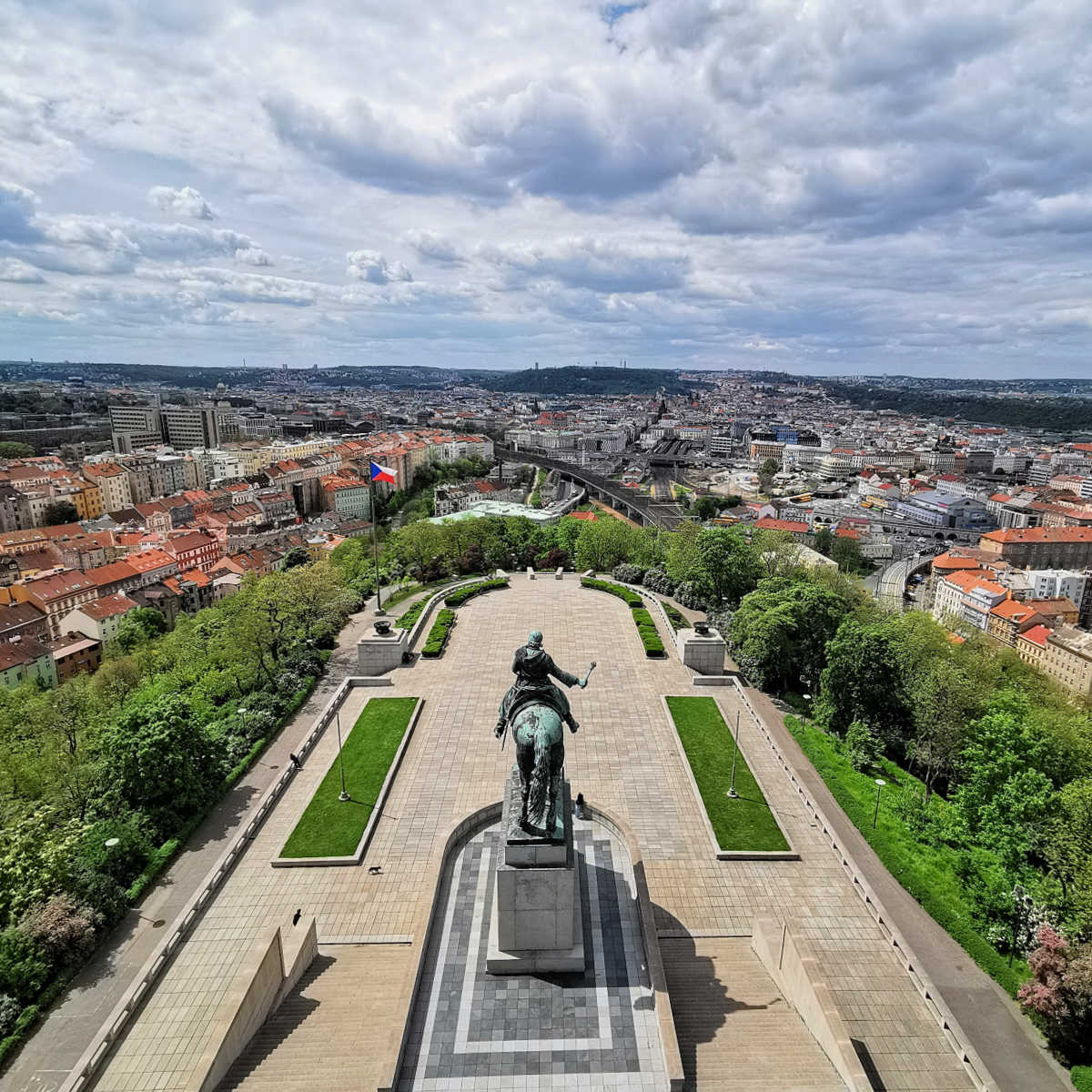
Ohrada
I’ve recently discovered that if you get off here you can walk to Vitkov Hill on a fairly level surface through a nice park. It’s perfect if you travel as a family with small children or simply don’t want to climb the steps under the Vitkov Hill Monument.
Vozovna Zizkov
Strazni
If you walk up Strazni Street and turn into the street called ‘V Domove’ you will arrive at a purposefully built area of houses from the 1920s called the ‘Kolonie Domov‘ (Colony Home).
The family houses were built by the Domov Building Cooperative between 1921-1925 based on the designs of architect Ladislav Machoně. The houses were built for the employees of the Domov Building Cooperative and were designed to look like a smaller version of village houses with small gardens and backyards to keep small farm animals, like chickens or rabbits). This was done, so that the houses would remind the new employees of the villages they came from and would make their new life in the busy metropolis more enjoyable. The streets have names such as Hraniční (On the Border), Na Balkáně, Na Hlídce, Strážní, V Bezpečí (In the safety), and V Domově (At Home).
If you fancy standing in the middle of Prague, head up the hill towards the children’s playground. Here, next to a large play sand pit, you’ll find the official geographical middle of Prague. Next time when your friends ask you whether you’ve been to the centre of Prague (them thinking – Prague Old Town Square…) you can happily tell them, that ‘Yes, I’ve actually been to the real centre of Prague!’
Chmelnice
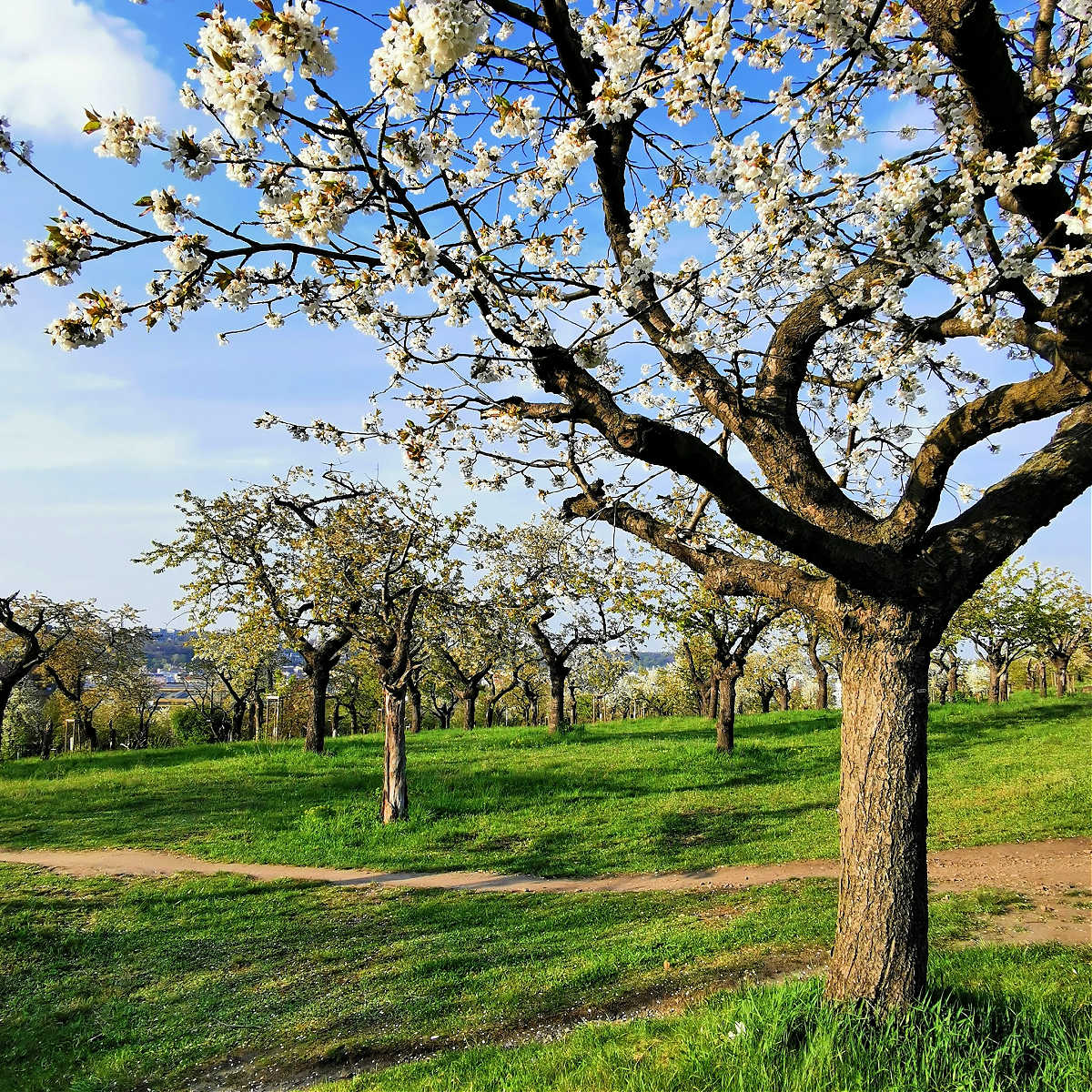
Knezska Luka or Spojovaci
This is another fantastic walk I’ve recently discovered. If you get off at Knezska Luka or the final stop Spojovaci, you can walk to the largest cherry orchard (Sad Tresnovka) in Prague.
The orchard is on a hill and you can continue walking towards Hloubetin or carry on following the river Rokytka to Stare Kyje and even further into Pocernice. The walk goes through a mixture of fields, woodland, river banks and quiet paths in the natural reserves. The walk is not marked as such, but you can easily follow it on Google maps.
You can get back to the Prague centre at any point as there are many buses and also trains to take you back. Although it might feel like you are miles away, your Prague day travel card (or the 90 min individual ticket) will be valid on any bus or train in the area.
PIN TO KEEP FOR LATER

This blog post was originally written on 24 May 2023 and last updated on 24 May 2023
